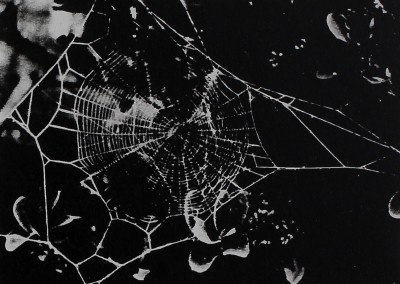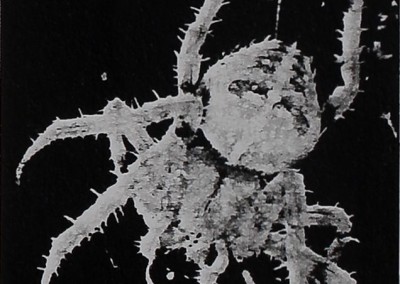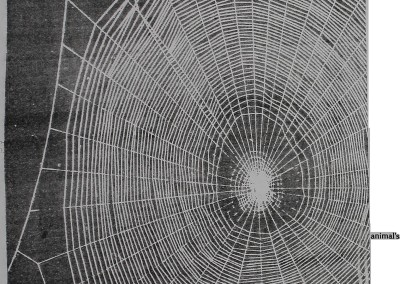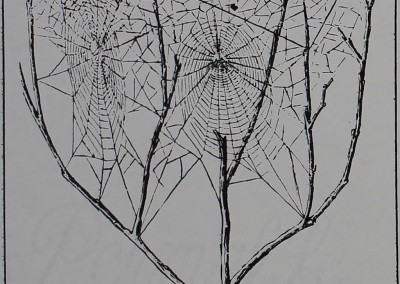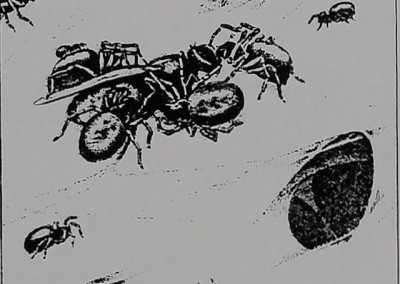Images Collection
Read OCR Digitized Article Text
NOTE: This plain text article interpretation has been digitally created by OCR software to estimate the article text, to help both users and search engines find relevant article content. To read the actual article text, view or download the PDF above.
Science News
Unraveling the Spider’s Web
BY SUSAN WEST
Of the approximately 35,000 identified species of spiders, only half spin webs; the rest hunt. Yet, for most people, the words spider and web are inseparable; it is the web that makes a spider unique. After all, without a web, the spider would have had no place to invite the fly.
But a web is much more than just a spinner’s grocery basket. For the spider, nearly blind, the web is a vibrating extension of its senses. Depending on the signals transmitted by the fine threads, the spider can tell, for example, the size and location of its prey. The web is a spider’s home and protection, its mating platform and its nursery.
The web is also the key to a spider’s ; social behavior, according to the most recent research. Studies by Peter N. Witt, ! chief of Mental Health Research at the North Carolina Department of Human Resources in Raleigh, and J. Wesley Burgess, now completing a doctorate at North Carolina State University, have shown that webs cue spiders to hunting, feeding, mating and egg-laying behavior. Web-builders appear to have one of three lifestyles: Some live completely alone, others live in groups but have separate households and activities and still others are communal— living, hunting, and feeding together and building communal egg sacs! In each case, the web reflects and often influences the lifestyle, Witt told a meeting of science writers in Gatlinberg, Tenn., last fall.
So what exactly is a web? Chemically, it is composed of a protein called fibroin, primarily the amino acids alanine and glycine. The silk is produced by six kinds of glands in the abdomen, each making a different type of thread. The silk is released through small organs on the abdomen called spinnerets. Different silks are used for egg sacs, hideaways, the frame, the temporary scaffolding of a web, the sticky spirals that trap insects and are also used for wrapping prey. Some species have a structure called a cribellum in addition to the spinnerets that combs the emerging silk into wooly, even more entangling snarls.
Web building is inherited behavior; all members of a species, even though most never encounter their parents, build from the day they are born. Each species has a specific design—a certain-sized mesh, for instance — but an individual spider’s web
Orb-shaped web typical of those used by solitary-living spiders to trap prey.
is as distinctive as a fingerprint. Witt says he has no trouble recognizing one of his spiders by its web if it builds in a different corner of the laboratory cage. Using cluster analysis — a computer technique that “recognizes” features much like our brain recognizes a face—Witt has found that an individual’s web resembles that of its parents more than those of other members of its species.
A web is built for economy of materials and energy. Seemingly following architectural principles, spiders — particularly those that build the familiar orb-shaped webs — manage to span the maximum area with a minimum of silk. It is, Burgess and Witt say, as though the spider were building a “prototype for mass production.” In an orb web, for example, all the spokes, or radii, are laid down first. The angles between the radii are nearly equal or are multiples. The spider then makes a few loosely spaced spirals of dry thread and, using these like a scaffolding, lays down a tighter mesh of sticky spirals.
Most orb weavers rebuild every 24 hours, taking down and eating the sticky spiral and leaving the essential radii and frame threads. The entire process, usually done in the hours just before dawn, takes only about 30 minutes. And, ever efficient, the orb weaver calculates the size of the web so that nearly all the silk in its glands is used. If robbed of some silk as it begins to weave, the spider reduces the number of radii to compensate for the loss.
Female orb weaver Araneus diadematus drinking a drop of water (dark sphere at bottom of picture).
Little energy is used in the process — Witt says a “fly and a half to two {out of possibly 30 eaten per day] pays the expenses.” And his studies have shown that orb weavers, at least, recycle their webs. Experiments in which spiders were fed another spider’s radioactively labeled web revealed that 95 percent of the material i showed up in the web built 24 hours later.
The web design chosen by the approximately 6,000 kinds of solitary spiders is perfectly suited to its “singles” lifestyle. Whether it sits at the hub of its silken spokes or builds a hidden retreat, its legs
Unraveling theSpidersWèb
A spider’s web is more than just a fly-catcher. Now, researchers think it may hold clues to the evolution of social behavior.
SCIENCE NEWS, VOL. 115
WillH McCook

Examples of the communal webs built by the Mexican species Mailos gregalis. The social tolerance that is absent in the solitary spider and imperfect in the compromise spider is complete in this species.
webs. The males stop spinning at a very young age and. says Witt, “just sit in corners or wander around in everybody’s way.“) Besides attracting him. the web acts as the suppliant’s intermediary. By reper.c-


Community action: Male, female, adult and immature M. gregalis, attracted by web-carried wing vibrations of a trapped, buzzing fly, attack and feed en masse.
Schematic drawing of the “compromise webn of Metepiera spinipes. Females, aggressive, lone hunters while on their oval trapping webs, become quite sociable when they move onto the community-built sheet web above the orb webs.
lightly touch the radii of its trap. At the slightest vibration, be it from fly. finger or tuning fork, it plucks at the radii until it finds the sector where there is unusual weight, runs along the dry threads until it reaches its victim and then bites and
wraps it (or vice versa). The lone spider is hardly a discriminate hunter: it will attack anything, including its would-be mate. Apparently, says Witt, it is the web itself of a mature female that attracts a male. (As adults, only female orb weavers build

edly drumming in a characteristic way, then swinging away from its intended’s running attacks, the male finally convinces the female with its ardor.
However, the female orb weaver is not always so predaceous. As a spiderling. it lives pleasantly enough with its siblings, even building a communal web and hunting in a pack. This arachnidal bliss lasts only about two weeks; as soon as the solitary spider builds its first orb, it loses all tolerance for company.
The answer to such unseemly behavior might lie with another type of web spinner, one that Witt suggests represents the orb weaver’s ancestor. Species such as Metepeira spinipes build an “urban-zoned” Continued on page 126
… Spiders
web: Individual females build solitary trapping webs which they renew regularly, but they care for their young and mate on an adjoining permanent, community-built web. Such spiders live a double life, Witt and Burgess have found: Like the solitary spider, the female is completely intolerant of any intruders on its trap, but on the community web that may serve 1,000 individuals. male, female, adults and young mix with few territorial restraints.
Witt and Burgess maintain it is the web type that cues M. spinipes s behavior. On the irregularly shaped, sheet-like community web, the female “knows” to mind its manners, and males and spiderlings do not venture onto the trapping web lest they become dinner. “It is a problem for spiders,” says Witt. “Other spiders taste just as good as anything else. So nature must have built in a way for it to tell how to behave. It appears it is the web type.” Perhaps, Witt and Burgess suggest, the ability to construct both kinds of webs is inherited. M. spinipes appears to express both talents, but the adult solitary spider may have lost, through evolution, access to communal web-building behavior.
Another social spider —Oecobius civi-tas — may represent an intermediate between the composite-web builder and the solitary spider. O. civitas, Burgess found, aggregates with other spiders but combines an unusual mixture of tolerance and avoidance. On the underside of a rock, where the spiders live together, each individual builds an open-ended tube that is its hiding place and an alarm net to alert it to approaching prey. When the alarm is tripped, O. civitas rushes out, -lassoes its victim and, circling it, wraps it in silk. Only the hunter eats the prey; nearby spiders do not partake. Though neighbors do not attack one another, the mingling spirit found in M. spinipes is not apparent. If an O. civitas is startled out of its hiding place, it may take refuge in a neighbor’s retreat. The neighbor neither attacks nor stays to entertain, but gives up its home and darts into another spider’s retreat.
The ultimate social spider, however, shares home, food and egg laying. Only five totally communal species have been identified so far; Witt says they may be the most recent development in spiders’ 3.5-million-year-old evolutionary tree. All five species have been found in tropical climates such as Mexico, Africa, India and Australia, occupying, according to Witt, habitats that are usually unfavorable to solitary dwellers.
The Mexican species Mallos gregalis, first described in 1908 and rediscovered by Burgess in 1975, builds huge, multi-layered webs spanning several branches of a tree. Burgess once encountered a M. gregalis web that covered the limbs and branches of the upper three-quarters of a 60-foot mimosa tree. The web, a permanent, ever-expanding structure that may serve several hundred thousand of the 5-
millimeter-long creature , is mutually constructed; tl ? work begu. i by one spider may be finished by another. The finished product has individual retreats, special chambers where females live with communally laid egg sacs and a surface sheet pocked with tunnels connecting to the interior. Hapless insects that become entangled are pounced on by several spiders, male and female, immature as well as adult. Even if the spiders have been starved, according to Burgess’s work, they will not take away another’s food. Though attacking spiders are quit? agg essive. Burgess notes, they never turn c n each other.
The mechanism responsible for such tolerance seems to involve the acoustical properties of the web. Using anesthetized flies, flies with immobile wings and normally mobile flies, Burgess found that M. gregalis only pays attention to buzzing flies, and the more the fly buzzes, the more spiders it attracts and the quicker they attack. It is the web-carried wing vibrations of the trapped, buzzing flies that attracts the spiders, but the web must also carry the vibrations of the thousands of inhabitants. What protects them? Burgess found that the web is a selective transmitter; it suppresses some signals while enhancing others. Moreover, Burgess has found that the signals it augments lie between 40 and 500 cycles per second, which just happens to include the frequency range of the buzz of a fly’s wings. Conveniently, the web’s properties offer protection as well. The buzzing of a mired honeybee, at more than 1,000 cycles per second, attracts no attention.
Communication by web also solves the courtship problem. To overcome the solitary spider’s reluctance, elaborate courtship, is necessary, but in the familiarity of the communal web, no such ritual is needed. The male “advertises” by drumming on the web in a specific way and only mature females answer the call.
To Burgess, the spider serves as a model for studying the evolution of social behavior such as communication and communal living in all animal species. His recent work on how spiders distribute themselves —M. gregalis forms cluster of threes while solitary spiders get as far apart as possible — implies there is an active form of communication between the animals. There is evidence, based on his studies, that chemical signals and surface textures may clue spiders that “oh god, this is my sister,” as Witt says. Spiders, which seem to have adapted to a variety of lifestyles and habitats, may offer answers to the ways individuals and communities solve problems. In addition, Witt has studied their problem-solving responses in terms of changes in web-building to various drugs. He suggests they may offer an excellent laboratory model for testing behavior-altering effects of drugs. Says Witt: “It’s a look at the world through spiders.” O
FEBRUARY 24, 1979
123
126
